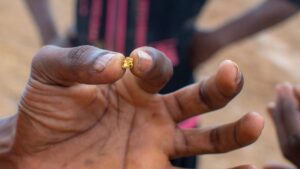Diggers and Dealers: Are you sleeping on West Africa? This 5Moz gold explorer suggests you take a closer look

Pic: dmaroscar/iStock via Getty Images
A gold explorer confident it’s on the way to delivering the African continent’s next Tier-1 gold mine says investors continue to sleep on the bountiful region despite years of success from western gold miners.
Two of Australia’s top-performing gold producers in recent years, the eponymous West African Resources (ASX:WAF) and Perseus Mining (ASX:PRU), are in the region and collectively worth in excess of $3 billion.
Tietto Minerals (ASX:TIE), with its Abujar mine in Cote d’Ivoire, is the latest on the ASX to bring a large-scale gold mine to commercial production.
Predictive Discovery (ASX:PDI) ran hot between 2020 and 2022, rising almost 30 times over as its Bankan discovery in Guinea emerged as a major new deposit in the rich Siguiri belt, part of a gold domain known to host upwards of 300Moz of gold resources.
Concerns around its location on the outer buffer zone of a nature reserve that prompted a management overhaul have played a big role in keeping enthusiasm for the stock in check since then.
Despite growing the Bankan resource to 5.38Moz today, the stock remains around 35% down on its 2022 highs, valuing the former project generator at around $360 million.
Speaking to journalists on the sidelines of the Diggers and Dealers Mining Forum in Kalgoorlie-Boulder today, Pardey said West African gold stocks continued to get shortchanged for the quality of their resources.
“I think Australia also in a lot of cases doesn’t understand West Africa, to be perfectly honest,” he said.
“And it’s a regular question I get asked: “Well, why don’t you move somewhere else?”
The best place to find a gold mine
Western miners operating in Africa have regularly complained of the ‘African discount.’
Robert Friedland, the Canadian entrepreneur famed for his role in the discovery of the Voisey’s Bay nickel mine in Canada, Oyu Tolgoi copper-gold project in Mongolia and now the Kamoa-Kakula copper mine in the DRC, went on a legendary rant last year about the NPV discount applied to his Ivanhoe Mines by analysts.
A scoping study is due to be shared with the Guinean Government by the end of 2023 before approvals for the environmentally sensitive Bankan project are pursued next year.
But Pardey sees a potential project of 4-6Mtpa producing upwards 250,000ozpa at Bankan, something that would place it firmly in the ASX mid-tier gold crowd if it could be brought to fruition.
“Production will be somewhere – you can do the sums yourself – but production will be in excess of 250,000 ounces with a mine life of at least 12 years,” he said.
“So that’s why we’re calling it what we believe to be West Africa’s next tier one asset.
“I often get asked the question as well, ‘what is it similar to?’ and the only similarity here I can compare it to is Papillon and Fekola, but when B2Gold bought Fekola, they were at 4.2Moz.
“They had over 200km of drilling into the project. We’re now at 5.4Moz, and we’ve got just over 86 kilometres of drilling into the project and you look where Fekola has gone and what it’s producing for B2Gold.”
Fekola now produces around 600,000ozpa. “That’s a huge mine,” Pardey said.
He says the margin of the Siguiri Basin is the best place to look for a new gold mine.
“If you want to find the next gold deposits in West Africa, you look on that basin margin. And that’s exactly where we sit,” he said.
“You look at it now and you think well, that’s a no brainer, but hindsight is wonderful.”
Jurisdictional risk?
The other, obvious, concern is jurisdictional risk. In particular the political instability of West African nations including Mali and Guinea have raised the unpredictability of the operating environment.
But Guinea’s military junta has since become increasingly pro-mining.
The country is already the third-largest bauxite exporter in the world, and is pushing to develop alumina refining on its own shores.
It is also broking a deal to enable the multi-billion dollar development of the Simandou iron ore mine in partnership with Rio Tinto (ASX:RIO) and Chinese entities.
“Those iron ore projects should have been developed years ago. I remember when I was first in Guinea, in 1998, and I can remember them just really pretending to do exploration,” he said.
“I think it’s a good thing for Guinea. Guinea is really pushing now – it’s the biggest exporter of bauxite, actually getting some refining of the bauxite to alumina.”
Predictive Discovery (ASX:PDI) share price today:

UNLOCK INSIGHTS
Discover the untold stories of emerging ASX stocks.
Daily news and expert analysis, it's free to subscribe.
By proceeding, you confirm you understand that we handle personal information in accordance with our Privacy Policy.








